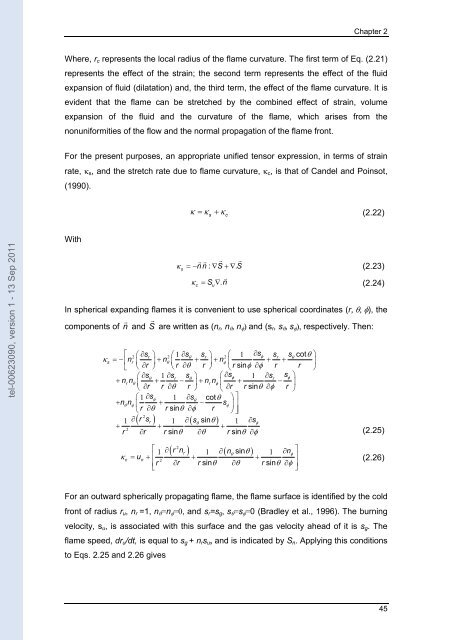Etude de la combustion de gaz de synthèse issus d'un processus de ...
Etude de la combustion de gaz de synthèse issus d'un processus de ...
Etude de la combustion de gaz de synthèse issus d'un processus de ...
You also want an ePaper? Increase the reach of your titles
YUMPU automatically turns print PDFs into web optimized ePapers that Google loves.
Chapter 2<br />
Where, r c represents the local radius of the f<strong>la</strong>me curvature. The first term of Eq. (2.21)<br />
represents the effect of the strain; the second term represents the effect of the fluid<br />
expansion of fluid (di<strong>la</strong>tation) and, the third term, the effect of the f<strong>la</strong>me curvature. It is<br />
evi<strong>de</strong>nt that the f<strong>la</strong>me can be stretched by the combined effect of strain, volume<br />
expansion of the fluid and the curvature of the f<strong>la</strong>me, which arises from the<br />
nonuniformities of the flow and the normal propagation of the f<strong>la</strong>me front.<br />
For the present purposes, an appropriate unified tensor expression, in terms of strain<br />
rate, κ s , and the stretch rate due to f<strong>la</strong>me curvature, κ c , is that of Can<strong>de</strong>l and Poinsot,<br />
(1990).<br />
κ = κ + κ<br />
(2.22)<br />
s<br />
c<br />
tel-00623090, version 1 - 13 Sep 2011<br />
With<br />
<br />
κ<br />
s<br />
=−nn: ∇ S+∇.<br />
S<br />
(2.23)<br />
κ = S ∇.<br />
n <br />
(2.24)<br />
c<br />
u<br />
In spherical expanding f<strong>la</strong>mes it is convenient to use spherical coordinates (r, θ, φ), the<br />
components of n and S are written as (n r , n θ , n φ ) and (s r , s θ , s φ ), respectively. Then:<br />
⎡<br />
2⎛∂sr ⎞ 2⎛1 ∂s<br />
2 1 s<br />
θ<br />
sr ⎞ ⎛ ∂<br />
φ sr<br />
sθ<br />
cotθ<br />
⎞<br />
κs<br />
=− ⎢nr<br />
⎜ n n<br />
r<br />
⎟+ θ ⎜ +<br />
φ<br />
r θ r<br />
⎟+ ⎜ + + ⎟<br />
⎣ ⎝ ∂ ⎠ ⎝ ∂ ⎠ ⎝r sinφ ∂φ<br />
r r ⎠<br />
⎛∂s<br />
1 s<br />
s<br />
r<br />
s<br />
φ 1 s s<br />
θ<br />
∂<br />
θ ⎞ ⎛∂<br />
∂<br />
r φ ⎞<br />
+ nn<br />
r θ ⎜ + − nn<br />
r φ<br />
r r θ r<br />
⎟+ ⎜ + − ⎟<br />
⎝ ∂ ∂ ⎠ ⎝ ∂r r sinθ ∂φ<br />
r ⎠<br />
⎛1 ∂sφ<br />
1 ∂sθ<br />
cotθ<br />
⎞⎤<br />
+ nn<br />
θ φ ⎜ + − sφ<br />
⎟⎥<br />
⎝r ∂θ r sinθ ∂φ<br />
r ⎠⎦⎥<br />
2<br />
1 ∂ ( r sr<br />
) 1 ∂ ( sθ<br />
sinθ<br />
) 1 ∂sφ<br />
+ +<br />
+<br />
2<br />
r ∂r<br />
r sinθ<br />
∂θ r sinθ ∂ φ<br />
(2.25)<br />
2<br />
( r nr<br />
) ∂ ( n sinθ<br />
)<br />
⎡ 1 ∂ 1 1 ∂n<br />
⎤<br />
θ<br />
φ<br />
κc<br />
= un<br />
+ ⎢ + + ⎥<br />
2<br />
⎢r<br />
∂r r sinθ ∂θ r sinθ ∂φ<br />
⎥<br />
⎣<br />
⎦<br />
(2.26)<br />
For an outward spherically propagating f<strong>la</strong>me, the f<strong>la</strong>me surface is i<strong>de</strong>ntified by the cold<br />
front of radius r u , n r =1, n θ =n φ =0, and s r =s g , s θ =s φ =0 (Bradley et al., 1996). The burning<br />
velocity, s u , is associated with this surface and the gas velocity ahead of it is s g . The<br />
f<strong>la</strong>me speed, dr u /dt, is equal to s g + n r s u , and is indicated by S n . Applying this conditions<br />
to Eqs. 2.25 and 2.26 gives<br />
45

















